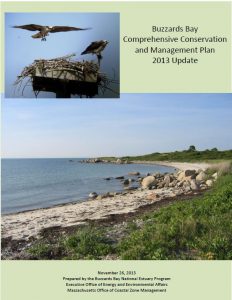2013 CCMP, Action Plan 17:
Preventing Oil Pollution
About the new Buzzards Bay CCMP Action Plans
The Buzzards Bay Comprehensive Conservation and Management Plan (CCMP) was updated in November 2013 to reflect the great progress achieved since the original CCMP was finalized. You can download the entire document (buzzards-bay-ccmp-2013-update.pdf) or just this action plan Preventing Oil Pollution Action Plan.
Action Plan 17: Preventing Oil Pollution
Problem
This action plan addresses catastrophic and chronic discharges of oil to Buzzards Bay and its surrounding watershed. These discharges of petroleum products have caused environmental degradation of water quality and habitat. To minimize future catastrophic spills and their impacts, improved navigation protocols need to be implemented, and environmental responses must be made effective through training and planning. The cumulative inputs of small chronic discharges of hydrocarbons from boat engines, stormwater, fishing fleets, and other sources often do not receive the same level of attention as accidental spills, but these inputs are also important.
The 2003 Buzzards Bay oil spill resulted in the passage of the 2004 Massachusetts Oil Spill Prevention and Response Act (MOSPRA) and companion legislation. The Act, required among other things, pilots, tug escorts, and oil delivery fees to fund oil spill response planning and training. Certain legal disputes between the federal government and Commonwealth are unresolved.
Goals
Goal 17.1. Reduce the amount of petroleum hydrocarbons released to Buzzards Bay.
Goal 17.2. Prevent the occurrence of oil spills in Buzzards Bay, both large and small.
Goal 17.3. Minimize the environmental effects from oil inputs to Buzzards Bay.
Objectives
Objective 17.1. To promote a regional strategy for preventing oil spills and hydrocarbon discharges.
Objective 17.2. To promote a coordinated and effective regional strategy for responding to large oil spills.
Objective 17.3. To implement a source-reduction plan for chronic inputs of hydrocarbons into Buzzards Bay.
Objective 17.4. To provide adequate facilities for the collection of waste oil from cars and boats.
Objective 17.5. To take enforcement actions against the illegal discharge of oil.
Approaches
Reducing future hydrocarbon discharges and impacts to Buzzards Bay will require decreasing the likelihood of catastrophic spills, improving the cleanup effectiveness and response time when spills do occur, better monitoring impacts after spills, and reducing chronic hydrocarbon release, like those associated with stormwater discharges and vessel operation in Buzzards Bay.
The presence of escort tugs for all oil barges and im-proved navigation aids and tracking will minimize future oil spills. To reduce future impacts of oil spills that do occur, increased local availability of response equipment, installation of boom anchorages, improved train-ing and coordination among municipalities, and periodic re-evaluation of response plans are continuing needs. Completion by NOAA of a water circulation oil spill trajectory model for Buzzards Bay will greatly improve predictions of the location of oil landings after a major spill. Installation of Physical Oceanographic Real-Time System (PORTS®), employed elsewhere around the country, will also assist with navigation, and spill model predictions. The state also needs to develop an oil spill damage assessment-monitoring plan, in collaboration with local universities and research centers, to establish a protocol to collect essential data quickly for the environmental damage assessments after a spill.
WWith respect to chronic discharges of oil, better treatment of permitted discharges, including stormwater, can further reduce hydrocarbon release. (Stormwater related hydrocarbon discharges are addressed further in Action Plan 3 Managing Stormwater Runoff and Pro-moting LID.) Strategies to reduce illicit discharges in New Bedford Harbor and Buzzards Bay may include remote camera monitoring of harbor activities and oil sheens, better enforcement, and services or a facility to collect oily bilge water from commercial vessels in the harbor. The increased use of 4-stroke engines will mini-mize hydrocarbon discharges from recreational boats. Municipalities can set an example by buying 4-stroke engines for harbormaster vessels. Local recycling pro-grams and education remain important strategies.
Costs and Financing
Estimated costs for these approaches are NRDA monitoring plan development, ~$80,000; NOAA circulation model, ~$100,000; PORTS®, $1 million installation, $200,000 annual operating costs; program to minimize illicit discharges to New Bedford Harbor, ~$200,000 in capital and $200,000 annual operating costs. Some costs might be eligible for MOSPRA funding, others through state and federal grants or appropriations.
Measuring Success
The effectiveness of measures to reduce large spills may take years to evaluate. Numbers of reported sheens and oil recovered from bilge water can be used to track measures to reduce small spills. Adoption of regulations with hydrocarbon BMP requirements can be enumerated. Reductions of nonpoint sources of hydrocarbons can only be evaluated programmatically.
